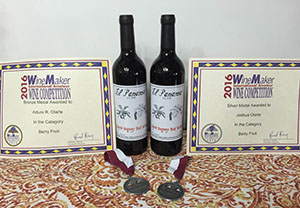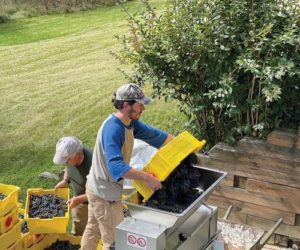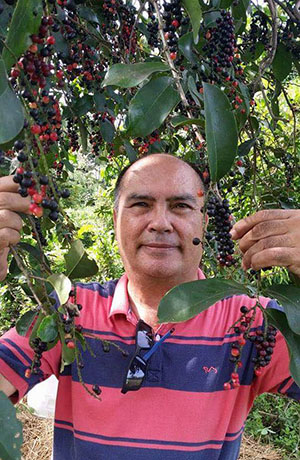
There are many fruits in the Philippines that are used to make fine wines, for instance our world-class mangoes, bananas, pineapples, papayas, etc., and other non-grape wines are also popular in some regions of the country.
There are a few famous wines and liquors in the Philippines made from things other than grapes with rich historical value: For instance, sugarcane wine (better known as basi) is famous in the province of Ilocos found in the northern region of Luzon. The sugar canes are extracted off for their juice, which is then fermented in 7-gallon (25-L) clay pots or jars that are embedded in the soil, sealed with a nipa sheet, and left for two to three months before consumption. There is also rice wine (better known as tupuy), which is popular in parts of the country where rice is abundant, such as Central Luzon, and the high altitude regions of Mountain Province and Benguet.
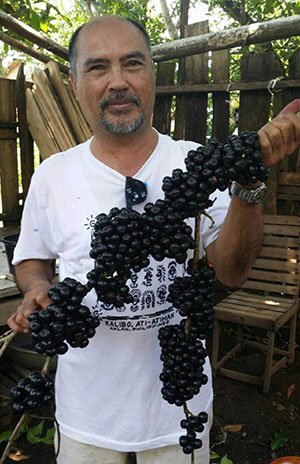
Consumption of red wine in the Philippines is mostly by people in the upper-middle to the upper class of society. In countries like France, Italy, etc. people from all social classes drink and appreciate wine, mainly because their respective countries produce the great wines, which gives them access to cheaper yet high quality wines.
While grapes are not abundant in the Philippines, over the past decade more people are beginning to learn that there are two berries that can be used to make red wine that can be comparable to the likes of Shiraz or Cabernet Sauvignon. Those are bignay/bugnay (scientific name: Antedesma Bunius) and lipote (scientific name: Syzygium Polycephaloides) mountain berries, which are abundant in the tropical rainforests of the southern and northern regions of Luzon.
The size of bignay berries range from 0.2–0.4 inches (6–10 mm) in diameter, while the lipote berries are about three times that size. Both of these berries start green and as they ripen turn dark violet or black and become very sweet in taste. Both berries have been studied at the University of the Philippines Los Banos to contain a high level of antioxidants, certain phytochemicals, flavanoids and vitamins. It is also said in the provinces that both berries are consumed as an aphrodisiac and helps male sexual vitality.
Until the past 10 years or so there had been no known use of these berries for making red wine. However, our country’s Department of Science and Technology have encouraged lower income people in the rural provinces to plant, grow, and in turn produce a wide variety of consumable products from native fruits in their respective provinces in order to create more livelihood and add income to their families. From this, wine was one of the “discoveries” for these berries.
Because traditional red wines are not so popular among many of our countrymen, one of the very noticeable downsides about the local winemakers in the provinces is that the red wine they produce from lipote and bignay lack consistency, and more often than not are sweet and lack the dryness that people who have knowledge about typical red wine are accustomed to.
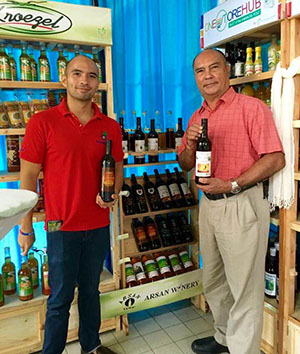
We also experienced our fair share of trials and errors with making wine from the local berries. I remember when my dad made the first batch it tasted more like grape juice than wine. We made sure with the next batch to choose a better performing yeast, which remained active long enough during fermentation to turn the sugar into alcohol, and make the wine taste more dry than sweet.
In his own initiative to help local farmers and improve the quality of red wine from the local berries, my father taught some farmers in Nueva Ecija and Quezon Province in Northern Luzon to plant, grow, harvest, and then crush lipote and bignay berries. My father then buys the juice from the farmers for around 450 Pesos (around $9) per 6-gallons (23-L) of juice to bring back to Metro Manila, where we ferment it into red wine.
Having done many trials and now becoming more confident with the quality and taste of our lipote and bignay wines, we decided to enter some of our wines into the WineMaker Magazine International Amateur Wine Competition in 2016 and were very thankful and happy that our entries placed two silver medals and one bronze medal in the berry fruit category in our first try in the competition. We have more to learn and discover about making red wine and we will not stop trying our best to improve Filipino-made red wine with the hopes that it will become more recognized on an international scale. My father has also dabbled into making whisky and brandy from these two berries.
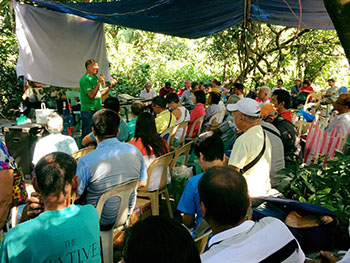 My father’s passion for making red wine also has turned him into a teacher for various municipalities and provinces in the Philippines. Since last year, he has been part of “Pangkat Kaunlaran,” a government-funded group that literally translates to “Development Group.” This group is composed of professors, entrepreneurs, and botanists who teach and share their knowledge on agriculture, irrigation, harvesting, and yielding better crops to local people in order to promote additional small scale businesses for the townsfolk.
My father’s passion for making red wine also has turned him into a teacher for various municipalities and provinces in the Philippines. Since last year, he has been part of “Pangkat Kaunlaran,” a government-funded group that literally translates to “Development Group.” This group is composed of professors, entrepreneurs, and botanists who teach and share their knowledge on agriculture, irrigation, harvesting, and yielding better crops to local people in order to promote additional small scale businesses for the townsfolk.
Making red wine has been such an enriching experience for me, as it made me more aware of the various winemaking techniques, but it also made me realize that red wine is more than just a drink that you pair with food, use for cooking, or consume to get drunk. Making red wine made me realize that it is a culture on its own. And I am thankful that with this hobby, this passion, I was able to bond more with my father, create more lasting memories, and keep learning from him in the process.


